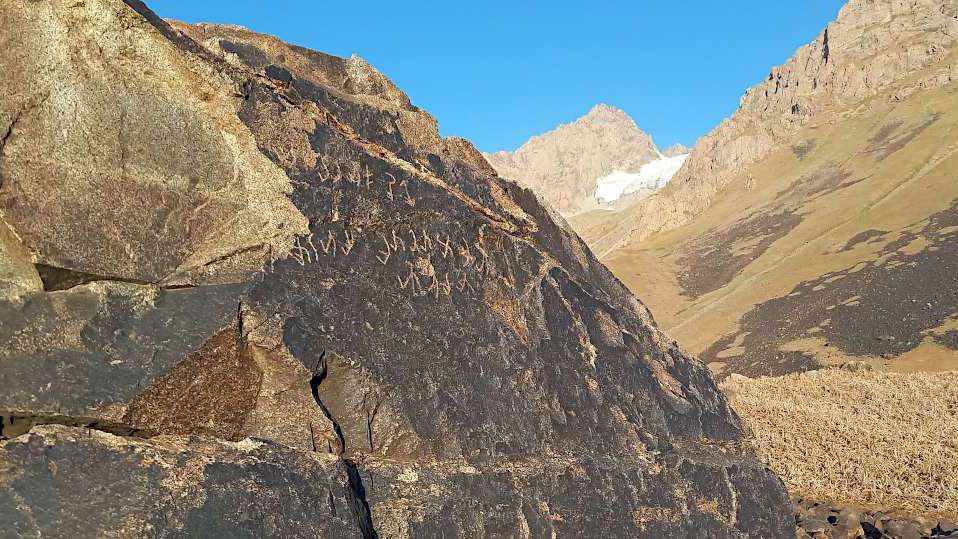Over a period of several years, Svenja Bonmann, Jakob Halfmann and Natalie Korobzow examined photographs of inscriptions found in caves and characters on bowls and clay pots from various Central Asian countries in order to gradually piece the puzzle together. On March 1, 2023, they announced their partial deciphering of the “unknown Kushana script” for the first time at an online conference of the Academy of Sciences of the Republic of Tajikistan. Approximately 60 percent of the characters can currently be read, and the group is working intensively on the rest.
New discovery brought the breakthrough
The “unknown Kushana script” is a writing system that was used in parts of Central Asia between ca. and AD 700 and can be associated with both early nomadic peoples of the Eurasian steppe, such as the Yuèzhī, and the ruling dynasty of the Kushana. The Kuschana founded an empire that was responsible, among other things, for the spread of Buddhism to East Asia. They also created monumental architecture and works of art.
So far, several dozen mostly short inscriptions are known, most of which come from the area of today’s states of Tajikistan, Afghanistan and Uzbekistan. There is also a longer text in three languages (trilingue) that was found by French archaeologists in the 1960s at Dašt-i Nāwur in Afghanistan: on a boulder at 4,320 m altitude on Mount Qarabayu about 100 km southwest of Kabul.
The writing system has been known since the 1950s, but has not yet been deciphered. In 2022, a short bilingual text (bilingual text) carved into a rock face was found in the Almosi Gorge in northwestern Tajikistan, about 30 km from the capital Dushanbe. In addition to the unknown Kuschana script, it also contains a section in the already known Bactrian language. This discovery led to several researchers independently attempting to decipher it again. In the end, the Cologne linguists succeeded in partially deciphering the writing system in cooperation with the Tajik archaeologist Dr. Bobomullo Bobomulloev, who was instrumental in finding and documenting the bilingual.
Success 200 years after the decipherment of the Egyptian hieroglyphs
The team used a methodology that was based on successful previous decipherments such as those of Egyptian hieroglyphs using the Rosetta Stone, Old Persian cuneiform or Greek Linear B script: Bonmann, Halfmann and Korobzow drew on the known content of the bilingual inscription from Tajikistan (Bactrian and unknown Kuschana script) and the trilingual inscription from Afghanistan (Gandhari or Middle Indo-Aryan, Bactrian and unknown Kuschana script) gradually draw conclusions about the script and language.
The breakthrough was finally made possible by the royal name Vema Takhtu, which appeared in both Bactrian parallel texts, and the title “King of kings”, which could be found in the corresponding sections of the unknown Kuschana script. The title in particular proved to be a good indicator of the underlying language. With the help of the Bactrian parallel text, the linguists were able to analyze further character strings step by step and always determine new phonetic values of individual characters.
Keys to a better understanding of Kushana culture
According to the research group, the Kushana script recorded a previously completely unknown Middle Iranian language. The language presumably occupies an intermediate position in the development between Bactrian and the so-called Khotansak language, which was once spoken in western China. It could either be the language of the sedentary population of northern Bactria (on part of what is now Tajikistan) or the language of some nomadic peoples of Inner Asia (the Yuèzhī) who originally lived in north-western China. For a period of time it apparently served as one of the official languages of the Kushana Empire alongside Bactrian, Gandhari/Middle Indo-Aryan and Sanskrit. The three researchers are tentatively calling the newly identified Iranian language “Eteo-Tocharian”.
The Cologne linguists are planning future research trips to Central Asia in close cooperation with Tajik archaeologists, since further inscriptions can be expected to be found and promising potential find sites have already been located. First author Dr. des. Svenja Bonmann says: “The decipherment can help to put our understanding of the language and cultural history of Central Asia and the Kuschana Empire on a new basis, similar to the decoding of the Egyptian hieroglyphs or the Mayan glyphs for our understanding of the ancient Egypt and the Mayan civilization did.”
